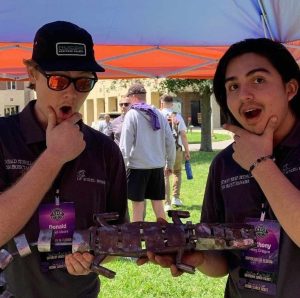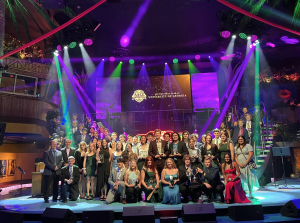The University of Florida’s Eckhoff Steel Bridge team made history this year achieving its fourth consecutive win at the American Society of Civil Engineers (ASCE) Southeast Student Symposium. The team placed first in key categories like Structural Efficiency and Construction Economy.
Additionally, for the first time in nearly a decade, UF’s ASCE student chapter posted back-to-back first place finishes in the regionals in Concrete Canoe, Steel Bridge, and overall competitions, repeating their run in 2014 and 2015. The steel bridge design team is a student group within the Engineering School of Sustainable Infrastructure & Environment (ESSIE), which houses the Department of Civil & Coastal Engineering and the Department of Environmental Engineering Sciences.

Read about the construction of the blueprint to the team’s success by hearing from Eckhoff Steel Bridge’s project managers, Anthony Perez Ortegon and Donald Stowell-Moore.
How did you learn about the Steel Bridge design team, and what motivated you to join?
Perez Ortegon, a civil engineering junior: “I learned about the team through the ESSIE website. As a student wanting to get involved, and as someone who liked to get their hands dirty, the UF Eckhoff Steel Bridge team seemed like the place to go.”
Stowell-Moore: “I heard about Steel Bridge through an ASCE general body meeting. A member gave updates on progress and was recruiting, so I reached out to get involved in fabrication and that’s where I got my start.”
Can you share your experience leading the Steel Bridge team, and what inspired you to take on a leadership role?
Perez Ortegon: “Being a leader on the team is a huge learning experience. It takes everything you have to live up to their expectations, not to mention your own. Despite that, I wanted to take on this role because I want to continue to develop this team as a space for students to get involved, learn new skills, and apply the concepts they’ve learned in the classroom.”
Stowell-Moore, a civil engineering senior: “Leading the team has been a challenging and fulfilling learning experience. After finding a groove with my co-project manager, we were able to set aside time in our schedules to work on class assignments. “
How do you balance the responsibilities of being a project manager with your academic commitments?
Perez Ortegon: “It can be difficult at times to juggle them, but personalized study habits, maintaining communication with professors, and coordinating my availability with the team have helped. Not to mention getting enough sleep.”
Stowell-Moore: “Balancing responsibilities is a challenge, but it’s all about finding your natural strengths and limitations and surrounding yourself with people who you can synergize with. It’s important to recognize those qualities in other people as well.”
[Best_Wordpress_Gallery id=”25″ gal_title=”2024 Steel Bridge Regional Competition”]
What strategies have you implemented to foster teamwork and collaboration within the team?
Perez Ortegon: “I’d say the most important strategy to encourage teamwork and collaboration within the team is to motivate team members to work in groups of at least two. Working in groups makes it easier for members to get to know each other as they work on a task or small-scale support project. For example, if someone is tasked with cleaning a workspace, multiple people will volunteer to help them. Students rarely work alone on this team. Two is a party, one is just a little boring. That’s why we have two project managers. It’s a culture that makes the team more enjoyable.”
Stowell-Moore: “Some of the challenges with managing a design team is making sure we keep new members engaged. The design process for Steel Bridge can be a lot to take in at first, but we find that students are able to pick it up and learn the skills quickly, if they are consistent with learning the process. Even underclassmen can learn how we design the bridge, but we try to focus on understanding the fundamentals of why we choose to make certain design choices. Most or all engineering projects require a holistic approach to better understand the design requirements, so we really try to encourage that mindset when designing the steel bridge.”

Both project managers anticipate nationals, viewing it as an opportunity for personal and team growth. They said they look forward to engaging with peers from other universities and gaining insights into different approaches to bridge design and team organization. They were vocal about the support they received from department faculty. They expressed their gratitude towards Mark Newman, Ph.D., their Steel Bridge faculty advisor, Taylor Rawlinson, Ph.D., and civil department head and undergraduate coordinator, Robert J. Thieke, Ph.D., for their invaluable guidance and support for the team. The team strives to continue their historic streak by clinching a fourth consecutive win at the American Institute of Steel Construction’s Student Steel Bridge Competition National Finals from May 31 to June 1 at Louisiana Tech University.
—
By Reba Liddy
ESSIE Marketing and Communications Specialist
